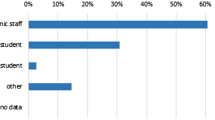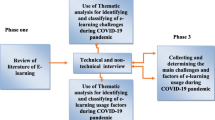Abstract
Content and services provided by a website should be accessible equally by all users including people with disabilities. Saudi Arabian universities are gradually shifting from traditional classroom teaching to online web-based teaching with the help of learning management systems (LMS). Transformation from traditional teaching system to online teaching systems demands that university website should be accessible by all users regardless of any disability. In this study, accessibility features of the Arabic version of thirty-three Saudi public and private universities are evaluated against thirty-eight success criteria of existing web content accessibility guidelines by using two automatic web accessibility evaluation tools (AChecker and TAW) to ensure that disabled users are able to perceive, understand, navigate and interact with the webpages. Accessibility violations detected by AChecker are categorized into 11% known problems and 89% likely and potential problems. Similarly, accessibility violations detected by TAW are categorized into 26% accessibility problems and 74% warnings. Accessibility evaluation results show that known accessibility problems detected by AChecker and TAW require immediate action to resolve but likely problems, potential problems and warnings require human involvement in the accessibility evaluation process. In this study, we proposed the alignment of detected accessibility violations with the WCAG 1.0 and WCAG 2.0 success criteria, which will be helpful to further identify the coverage level of automatic accessibility evaluation tool and main accessibility violation domain. Study concludes that automated web accessibility analysis tools are not alone capable to identify all accessibility issues in website due to the fact that they do not understand the way assistive technologies used by disabled persons to interact with web contents. However, the findings of this study recommend further comprehensive empirical research by involving the disabled users to discover the missing accessibility problems in Arabic version of websites. Furthermore, accessibility problems detected by disabled users’ further require aligning by accessibility experts with existing guidelines to identify the gap with user problems and existing web content accessibility guidelines.




Similar content being viewed by others
References
Mankoff, J., Fait, H.,Tran, T.: Is your web page accessible? A comparative study of methods for assessing web page accessibility for the blind. In: Proceedings of the SIGCHI Conference on Human Factors in Computing Systems, pp. 41–50, (2005)
Lazar, J., Dudley-Sponaugle, A., Greenidge, K.D.: Improving web accessibility: a study of webmaster perceptions. Comput. Hum. Behav. 20(2), 269–288 (2004)
Craven, J., Nietzio, A.: A task-based approach to assessing the accessibility of web sites. Perform. Meas. Metrics 8(2), 98–109 (2007). https://doi.org/10.1108/14678040710760603
Bickenbach, J.: The world report on disability. Disabil. Soc. 26(5), 655–658 (2011). https://doi.org/10.1080/09687599.2011.589198
U. N. Development Group: Including the rights of persons with disabilities in United Nations programming at country level, United Nations Development Gruoup, NY, USA, p. 126, (2011). https://www.un.org/disabilities/documents/iasg/undg_guidance_note_final.pdf. Accessed 25 Oct 2021
Rights of people with disabilities, Government of Saudi Arabia. https://www.my.gov.sa/wps/portal/snp/careaboutyou/RightsOfPeopleWithDisabilities. Accessed 23 July 2021
Al-Asmari, A.M., Khan, M.S.R.: E-learning in Saudi Arabia: past, present and future. Near Middle East. J. Res. Educ 2014(1), 1–11 (2014). https://doi.org/10.5339/nmejre.2014.2
Caldwell, B., Cooper, M., Reid, L. G., Vanderheiden, G., Chisholm, W., Slatin, J., White, J.: Web content accessibility guidelines (WCAG) 2.0. WWW Consortium (W3C), 290, pp. 1–34. (2008)
Abascal J., Arrue M., Valencia X.: Tools for web accessibility evaluation. In: Yesilada Y., Harper S. (eds.) Web Accessibility. Human–Computer Interaction Series, Springer, London (2019), https://doi.org/10.1007/978-1-4471-7440-0_26
Zahra, S. A., Steenhout, N., Keen, L.: “Selecting web accessibility evaluation tools”, World wide web consortium. (2020) https://www.w3.org/WAI/test-evaluate/tools/selecting/. Accessed 14 June 2021
Luján-Mora, S., Navarrete, R., Peñafiel, M.: Egovernment and web accessibility in South America. First Int. Conf. eDemocr. eGov. (ICEDEG) 2014, 77–82 (2014). https://doi.org/10.1109/ICEDEG.2014.6819953
Ahmi, A., Mohamad, R.: Evaluating accessibility of Malaysian public universities websites using AChecker and WAVE. J. Inf. Commun. Technol. 15(2), 193–214 (2016)
Peters, C., Bradbard, D.A.: Web accessibility: an introduction and ethical implications. J. Inf. Commun. Eth. Soc. 8(2), 206–232 (2010)
Petrie, H., Bevan, N.: The evaluation of accessibility, usability, and user experience. Univers. Access Handb. 1, 1–16 (2009)
Web Accessibility Benchmarking Cluster: Unified web evaluation methodology (UWEM 1.2), (2007). http://www.wabcluster.org/uwem1_2/. Accessed 21 Sept 2021
Gevorkian, D.: “Why using automated tools for testing web accessibility is not enough,” (2019), be accessible, https://beaccessible.com/post/why-using-automated-tools-for-testing-accessibility-is-not-enough/. Accessed 17 Sept 2021.
Vigo, M., Brown, J., Conway, V.: Benchmarking web accessibility evaluation tools: measuring the harm of sole reliance on automated tests. In: Proceedings of the 10th International Cross-Disciplinary Conference on Web Accessibility, pp. 1–10, (2013). https://doi.org/10.1145/2461121.2461124
Sambhanthan, A., Good, A.: Implications for improving accessibility to e-commerce websites in developing countries: a study of hotel websites. Int. J. Knowl. Based Organ. (IJKBO) 2(2), 1–20 (2012)
Dattolo, A., Luccio, F.L., Pirone, E.: Web accessibility recommendations for the design of tourism websites for people with autism spectrum disorders. Int. J. Adv. Life Sci. 8(3–4), 297–308 (2016)
Eusébio, C., Silveiro, A., Teixeira, L.: Website accessibility of travel agents: an evaluation using web diagnostic tools. J. Access. Des.: JACCES 10(2), 180–208 (2020). https://doi.org/10.17411/jacces.v10i2.277
Teixeira, P., Eusébio, C., Teixeira, L.: How diverse is hotel website accessibility? a study in the central region of Portugal using web diagnostic tools. Tour. Hosp. Res. 22(2), 180–195 (2021)
Akram, M., Sulaiman, R.B.: Comparative web accessibility evaluation of Saudi government websites for compliance with WCAG 1.0 and WCAG 2.0 using automatic web accessibility tools. J. Theor. Appl. Inf. Technol. 97(10), 2656–2668 (2019). https://doi.org/10.5281/zenodo.3256498
Serra, L.C., Carvalho, L.P., Ferreira, L.P., Vaz, J.B.S., Freire, A.P.: Accessibility evaluation of e-government mobile applications in Brazil. Proced. Comput. Sci. 67, 348–357 (2015)
Akgül, Y., Vatansever, K.: Web accessibility evaluation of government websites for people with disabilities in Turkey. J. Adv. Manag. Sci. 4(3), 201–210 (2016)
Adepoju, S.A., Shehu, I.S., Bake, P.: Accessibility evaluation and performance analysis of e-government websites in Nigeria. J. Adv. Inf. Technol. 7(1), 49–53 (2016)
Latif, M.H.A., Masrek, M.N.: Accessibility evaluation on Malaysian e-government websites. J. E-Gov. Stud. Best Pract. 2010(11), 1–11 (2010)
Masood Rana, M., Fakrudeen, M., Rana, U.: Evaluating web accessibility of university web sites in the Kingdom of Saudi Arabia. Int. J. Technol., Knowl. Soc. 7(3), 1–15 (2011)
Adepoju, S. A., Shehu, I. S.: Usability evaluation of academic websites using automated tools. In: 2014 3rd International Conference on User Science and Engineering (i-USEr) pp. 186–191. IEEE (2014). https://doi.org/10.1109/IUSER.2014.7002700
Chacon-Medina, A., Chacon-Lopez, H., Dolores Lopez-Justicia, M., Fernandez-Jimenez, C.: The state of web accessibility in Spanish universities according to WCAG 2.0., Rev. Esp. Doc. Cient., 36 (4), (2013)
Fatima, K., Bawany, N.Z., Bukhari, M.: Usability and accessibility evaluation of banking websites. Int. Conf. Adv. Comput. Sci. Inf. Syst. (ICACSIS) 2020, 247–256 (2020). https://doi.org/10.1109/ICACSIS51025.2020.9263083
Pandey, A.: Web application accessibility testing. Int. J. Sci. Res. Publ. 5(9), 2250–2253 (2015)
Alshamari, M.: Accessibility evaluation of Arabic e-commerce web sites using automated tools. J. Softw. Eng. Appl. 9(9), 439–451 (2016)
Yazid, M.A., Jantan, A.H., Abd Ghani, A.A., Kamaruddin, A., Admodisastro, N.: Accessibility design issues with Malaysian news websites: a case study using a checker and WAVE. Int. J. Eng. Technol. 7(4.31), 69–73 (2018). https://doi.org/10.14419/ijet.v7i4.31.23344
Rahmatizadeh, S., Valizadeh-Haghi, S.V.H.: Monitoring for accessibility in medical university websites: meeting the needs of people with disabilities. J. Access. Des 8(2), 102–124 (2018). https://doi.org/10.17411/jacces.v8i2.150
Sinha, Prashant, Web accessibility analysis of government tourism websites in India (April 27, 2018). Proceedings of 3rd International Conference on Internet of Things and Connected Technologies (ICIoTCT), 2018 held at Malaviya National Institute of Technology, Jaipur (India) on March 26–27, (2018). https://doi.org/10.2139/ssrn.3170191
Padure, M., Pribeanu, C.: Comparing six free accessibility evaluation tools.". Informa. Econ. 24(1), 15–25 (2020). https://doi.org/10.24818/issn14531305/24.1.2020.02
Barricelli, B.R., Casiraghi, E., Dattolo, A., Rizzi, A.: 15 Years of Stanca Act: are italian public universities websites accessible? Univers. Access Inf. Soc. 20(1), 185–200 (2021). https://doi.org/10.1007/s10209-020-00711-0
Sarita, K., Kaur, P., Kaur, S. (2022). Accessibility of healthcare sites: evaluation by automated tools. In: Saraswat, M., Roy, S., Chowdhury, C., Gandomi, A.H. (eds) Proceedings of International Conference on Data Science and Applications. Lecture Notes in Networks and Systems, vol. 287, pp. 625–636. Springer, Singapore. https://doi.org/10.1007/978-981-16-5348-3_50
Kurangi, C. R.: "Multi-tool evaluation of web accessibility for learning and development company websites", Turk. J. Physiother. Rehabil. 32(2). (2021)
Paul, S., Das, S.: Accessibility and usability analysis of Indian e-government websites using WCAG 2.1 evidence from Indian e-government websites. Univers. Access Inf. Soc. 19, 949–957 (2020). https://doi.org/10.1007/s10209-019-00704-8
Bai, Yang and Grzeslo, Jenna and Wang, Ryan and Min, Bumgi and Jayakar, Krishna : Does accessible design benefit general users of e-government? examining the relationship between website usability and accessibility (July 26, 2019). TPRC47: The 47th Research Conference on Communication, Information and Internet Policy (2019). https://doi.org/10.2139/ssrn.3427413
Paul, S.:Accessibility analysis using WCAG 2.1: evidence from Indian e-government websites. Universal Access Information Society. (2022). Doi: https://doi.org/10.1007/s10209-021-00861-9
Rømen, D., Svanæs, D.: Validating WCAG versions 1.0 and 2.0 through usability testing with disabled users. Univ. Access Inf. Soc. 11(4), 375–385 (2012)
Macakoğlu, ŞS., Peker, S., Medeni, İT.: Accessibility, usability, and security evaluation of universities’ prospective student web pages: a comparative study of Europe, North America, and Oceania. Univers. Access Inf. Soc. (2022). https://doi.org/10.1007/s10209-022-00869-9
Kous, K., Kuhar, S., Pušnik, M., Šumak, B.: Comparative analysis of faculties’ websites accessibility based on an automatic evaluation. In: 2019 42nd International Convention on Information and Communication Technology, Electronics and Microelectronics (MIPRO) (pp. 1498–1502). IEEE (2019). https://doi.org/10.23919/MIPRO.2019.8757202
Brajnik, G., Yesilada, Y., Harper, S.: Testability and validity of WCAG 2.0: the expertise effect. In: Proceedings of the 12th International ACM SIGACCESS Conference on Computers and Accessibility, pp. 43–50, (2010). https://doi.org/10.1145/1878803.1878813
Commission D. R., The Web: access and inclusion for disabled people; a formal investigation. Stationery Office, 2004
Harrison C., Petrie H.: Severity of usability and accessibility problems in ecommerce and egovernment websites. In: Bryan-Kinns N., Blanford A., Curzon P., Nigay L. (eds) People and Computers XX—Engage.pp.255–262, Springer, London, (2007). https://doi.org/10.1007/978-1-84628-664-3_19
Freire, A. P., Petrie, H., Power, C. D.: Empirical results from an evaluation of the accessibility of websites by dyslexic users, In: Proceedings of the Workshop on Accessible Design in the Digital World, pp. 41–53, (2011)
D. Rømen D., and Svanæs D.: “Evaluating web site accessibility: validating the WAI guidelines through usability testing with disabled users,” In: Proceedings of the 5th Nordic Conference on Human-Computer Interaction: Building Bridges, pp. 535–538, (2008). https://doi.org/10.1145/1463160.1463238
Akram, M., Bt Sulaiman, R., "An Empirical study to evaluate the accessibility of arabic websites by low vision users," 2020 8th International Conference on Information Technology and Multimedia (ICIMU), 2020, pp. 206–211, (2020). https://doi.org/10.1109/ICIMU49871.2020.9243565
Funding
The authors are thankful to the Deanship of Scientific Research at Najran University for funding this work under the National Research Priorities funding program grant code (NU/NRP/SERC/11/32).
Author information
Authors and Affiliations
Corresponding author
Ethics declarations
Conflict of interest
The authors declare that they have no conflicts of interest to report regarding the present study.
Additional information
Publisher's Note
Springer Nature remains neutral with regard to jurisdictional claims in published maps and institutional affiliations.
Rights and permissions
Springer Nature or its licensor holds exclusive rights to this article under a publishing agreement with the author(s) or other rightsholder(s); author self-archiving of the accepted manuscript version of this article is solely governed by the terms of such publishing agreement and applicable law.
About this article
Cite this article
Akram, M., Ali, G.A., Sulaiman, A. et al. Accessibility evaluation of Arabic University websites for compliance with success criteria of WCAG 1.0 and WCAG 2.0. Univ Access Inf Soc 22, 1199–1214 (2023). https://doi.org/10.1007/s10209-022-00921-8
Accepted:
Published:
Issue Date:
DOI: https://doi.org/10.1007/s10209-022-00921-8




